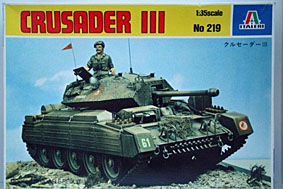
Feature Article by Steve Noble
Desert Encounter
A note from Geoff…
As you can see, this is a great project from Steve N. ‘Desert Encounter’ offers up another great opportunity to tell a story and for you to see something that Steve is particularly good at first hand. This project offers a perfect opportunity to combine figures, the main kit, ground-work and an animal!
Well done Steve, over to you…
Introduction
As a modeller, one of the most appealing armoured fighting vehicles for me to build has been the Crusader tank as its sleek lines always held a strong appeal.
The Crusader, which went into battle un-tested had a chequered history due to poor mechanical reliability arising from sand ingestion in the harsh desert conditions where it served. Despite this, it fulfilled a key role filling the gap in tank numbers at a critical point in the desert war. Its usefulness ended with the arrival of the Lee/Grant and Sherman. The Crusader tank also represented a turning point in design that would lead on to the Cromwell and eventually the Comet, the first and only cruiser tank to get the correct balance of firepower, armour and mobility.
The Mark 1 operated with a crew of five (commander, driver, gunner, loader and gunner in the auxiliary turret). During tests at the Lulworth firing range, the tank was considered to provide a good gun platform. Seeing combat for the first time during Operation Battle Axe in North Africa in 1941, the 2 pounder was found to be out-ranged by the 50mm gun of the Panzer 3 tanks. It was not until the second battle of El Alamein that the Crusader Mark 3 with its 6 pounder could match the Panzer 3. In fitting the 6 pounder, there was insufficient room in the turret for a loader. This additional duty had to be taken over by the commander. With the crew reduced to three (commander, gunner and driver) they were all overworked. The threat moved from the Panzer 3 to the Panzer 4 fitted with a new long 75mm gun, again leaving the Crusader out gunned and out-ranged.
While proving to be an agile tank the main complaint from its crews was that it frequently broke down. Using a Liberty engine made up of separate sets of cylinders rather than a single engine block, the rough terrain of the desert resulted in the cylinders working loose which resulted in fractured lubricant lines and failure due to leaks. The tank initially fitted with concertina air filters was prone to allow ingress of sand that would cause erosion of white metal parts and impact on the effectiveness of the cooling fans driven by double roller chains. To go some way to alleviating the problems the cooling fan system was changed to be driven by a drive shaft and the air filters changed to an oil bath type.

Filling the desperate need for tanks, without which the desert war could not have been fought, the Crusader was withdrawn from frontline service in mid-1943 before the invasion of Sicily. The arrival of the American designed Lee/Grant and Sherman tank with their high level of reliability, improved armour and firepower facilitated the withdrawal of the Crusader
Kits Past and Present
In terms of availability, Italeri produces the widest range of Crusader models being the only manufacturer in the most popular scale of 1:35th. Italeri provides five of the vehicles in the Crusader range which can largely be built straight from the box. All of the versions use the same basic hull and running gear dating from the 1970’s with new turrets, sand shields etc. ringing the changes.
The kits are reasonably priced but have a number of sink and ejector marks as can be expected from a kit of this age. These however are largely hidden on the finished model. Detail on the kits, while not matching the new cutting edge kits, is still of an good level with the exception of the rubber band tracks and gun barrels which are worth considering replacing. Internal detail is absent or where present it is naïve.
The company normally has at least two of the vehicles on release at any one time and periodically replaces them with others in the range. The range covers all three gun tanks and two of the AA tanks with the kits produced shown below.




